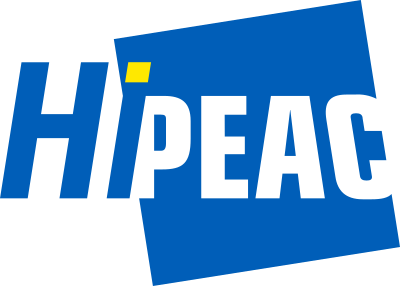HiPEAC 2020
Please, give us a feedback!
| Event | HiPEAC 2020 | ||||||||||||||||
| Where | Bologna | ||||||||||||||||
| When | 20 – 22 January, 2020 | ||||||||||||||||
| Event Website | https://www.hipeac.net | ||||||||||||||||
| Involved Partners | ALL | ||||||||||||||||
| Organizers | Francesca Palumbo (UNISS), Evgeny Shindin (IBM Research Haifa) | ||||||||||||||||
| Benefits & Target | Cerbero participation to the event aims at divulgation of the CERBERO toolchain capabilities among companies and researches attending at HiPEAC 2020 | ||||||||||||||||
| Description | Cyber-physical systems (CPS) represent the cutting edge of the ICT. They provide control, interaction and communication over, with and among the physical and the cyber world. CPS combine computing devices, interfaces, and networks with the environment to sense and provide feedback, increasingly often implementing autonomous and intelligent interactions. Dealing with CPS development requires spanning over a plethora of heterogeneous topics, which makes the process of their definition, analysis and design a challenging task. Moreover, to interact with the environment or humans the system has to be capable of providing a certain degree of flexibility, which certainly adds to the challenges. Tools to be used span from verification to modeling, and from mapping to high-level synthesis across many levels of abstraction, and must allow a combination of physical or continuous dynamics. Last but not least, CPS should react to and handle a large variety of possible perturbations, such as change in requirements, time delays, and system failures. All these issues have been fronted in CERBERO – Cross-layer modEl-based fRamework for multi-oBjective dEsign of Reconfigurable systems in unceRtain hybRid envirOnments H2020 project (www.cerbero-h2020.eu). This tutorial is meant to represent the final event of the project, and is organized in 4 slots as follows: | ||||||||||||||||
| Schedule |
|
Sessions Description
SESSION 1: The CERBERO Project – Challenges and Solutions
CERBERO overview, Francesca Palumbo (UNISS) – presentation
Scientific Highlights
- Advancement on (dataflow) MoCs, Eduardo Juarez (UPM) – presentation
- CERBERO Intermediate Format CIF, Evgeny Shindin (IBM Research Haifa) – presentation
- Key Performance Indicators, Francesco regazzoni (ALaRI – USI) – presentation
- CEBERO Adaptation Loop, Eduardo de la Torre (UPM) – presentation
- Formal methods in the CERBERO Toolchain, Luca Pulina (UNISS) – presentation
SESSION 2: HANDS on “Tools Interoperability – Intra-tool interoperability using the CERBERO Interoperability Framework”
The development of a direct connection between tools can be a lengthy process, especially when inner tool data models change and therefore the interface between tools should change as well. The CERBRERO Interoperability Framework (CIF) offers a way to easily cope with model adaptations. This workshop will offer a hands on tutorial on how to use CIF. As an example we will discuss a use-case from the integration between DynAA and Preesm (both CERBERO tools).
Speakers: Julio Oliveira (TN0) and Michiel van den Baar (TNO) – Presentation
Speakers: Julio Oliveira (TN0) and Michiel van den Baar (TNO) – Presentation
SESSION 3: HANDS on “Adaptation over Heterogeneous Embedded Computing Infrastructures”
Often deployed in hard-to-reach environments, CPS are meant to be dynamic, providing efficient ways to adapt to mutable and evolvable requirements. Self-adaptation aims at changing structure, functionality or parameters of the systems according to internal and external triggers and in general it needs both architectural and tooling support. This workshop will offer a hands on tutorial on how to use PREESM, SPIDER, PAPIFY-ARTICo3, and MDC tools to implement and manage self-adaptation over an embedded heterogeneous processing platform.
Speakers: Tiziana Fanni (UNISS), Daniel Madroñal (UPM), Maxime Pelcat (INSA), Alfonso Rodriguez (UPM), Carlo Sau (UNICA), Leonardo Suriano (UPM) – presentation
Speakers: Tiziana Fanni (UNISS), Daniel Madroñal (UPM), Maxime Pelcat (INSA), Alfonso Rodriguez (UPM), Carlo Sau (UNICA), Leonardo Suriano (UPM) – presentation
Download Virtual Machine for Adaptation over Heterogeneous Embedded Computing Infrastructures: link
Tutorial Guide: link
SESSION 4: The CERBERO Project – Impact, Demo and Clustering
Market Trends and Exploitation Potentials for CPS – CERBERO path to market, Speaker: Katiuscia Zedda (AI) – presentation
Clustering: DEIS, BONSEYES, CPSWARM
Walking UC DEMO tour
Self-healing system for Planetary Exploration, Speaker: Pablo Sánchez de Rojas(TASE) – presentation
Smart Traveling for Electric Vehicles, Speakers: Joost Adriaanse (TNO), Antonella Toffetti (CRF) – presentation
Ocean Monitoring, Speakers: Hans Myrhaug (AS), Leszek Kaliciak (AS) – presentation
Clustering: DEIS, BONSEYES, CPSWARM
Walking UC DEMO tour
Self-healing system for Planetary Exploration, Speaker: Pablo Sánchez de Rojas(TASE) – presentation
Smart Traveling for Electric Vehicles, Speakers: Joost Adriaanse (TNO), Antonella Toffetti (CRF) – presentation
Ocean Monitoring, Speakers: Hans Myrhaug (AS), Leszek Kaliciak (AS) – presentation
1. Self-healing system for Planetary Exploration demonstrator: The demonstrator highlights the main challenges of the use case: fault detection and recovery, (self-)adaption and power monitoring and optimization at a computing platform level. The application scenario tackles the generation and validation of collision-free trajectories for a robotic arm. An optimization-based motion planning algorithm integrates with the CERBERO tools and technologies in different ways: ARTICo3 (UPM-CEI) provides dynamic partial reconfiguration, transparent scalability and adjustable redundancy. PAPIFY (UPM-CITSEM) features automatic monitoring of the hardware accelerators. MDC (UNISS and UNICA) enables virtual reconfiguration intended to provide fast-switching between different implementations of the algorithm.
2. Smart Traveling for Electric Vehicles demonstrator: During the project a demonstrator was built on top of the driving simulator of CRF (Fiat/Chrysler Research) in Turin, Italy. The demonstrator added electric vehicle simulation using battery and electric motor models and a driving assistant. The assistant monitors the car, the environment and the driver during the trip and proactively provides advice on best itineraries to drive, taking into consideration the preferences of the driver. The DynAA tool from TNO supports system-in-the-loop simulation and itineraries predictions. The MECA tool from S&T provides the planning engine of the assistant. In the demonstrator the DynAA and MECA tools are integrated in the SCANeR simulation software used by CRF. The demonstrator will allow CRF to execute test scenarios for electric vehicles were driver is supported with a driving assistant to address issues like state of charge of the battery and finding the best charging options while driving. During the demo video recording will be shown of the actual demonstrator implemented at CRF in Turin.
3. Ocean Monitoring Demonstrator: Ocean monitoring (OM) can encompass a range of purposes – from observing and tracking marine ecology and climate, to subsea maintenance of equipment. The CERBERO Ocean Monitoring use case comprises smart video-sensing (an adaptive camera) uncrewed vehicles with immersive environmental monitoring capabilities. OM adopts the CERBERO new development methodology for the complete CPS design cycle – to reduce cost and development time, improve reuse, track and improve a range of KPIs, and enable incremental prototyping. OM uses the CERBERO toolchain for fast, incremental prototyping, reduced development risk, and reduced cost. This use case applies the CERBERO adaptivity framework as its architectural pattern.
Useful Information for HANDS on Sessions
Two hands on will be given to allow the participants getting familiar with some of the CERBERO outcomes. To enjoy these tutorials, participants should install in their laptops the software Oracle-VirtualBox (you can download it at https://www.virtualbox.org/).
We will bring the installer (you can find us at the booth since Monday), but installing it in advance is advisable.
Please note that,
- Network connection for the virtual box is not necessary.
- Images and installer will be available at the booth since Monday, if you do not have time to download the images before you leave for Bologna.
- Images will be also distributed at the beginning of the tutorial by circulating them in the classroom.


 © 2017 CERBERO | All Rights Reserved |
Project ID: 732105,
Funded under: H2020-EU.2.1.1. - INDUSTRIAL LEADERSHIP - Leadership in enabling and industrial technologies - Information and Communication Technologies (ICT).
© 2017 CERBERO | All Rights Reserved |
Project ID: 732105,
Funded under: H2020-EU.2.1.1. - INDUSTRIAL LEADERSHIP - Leadership in enabling and industrial technologies - Information and Communication Technologies (ICT).